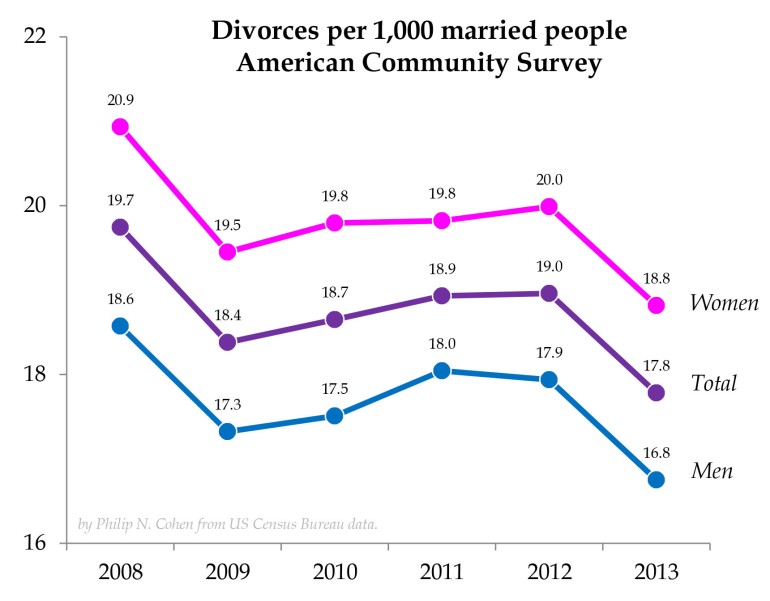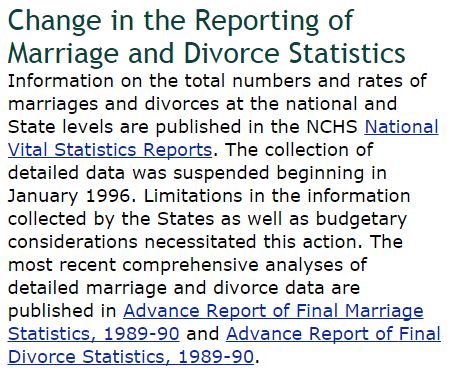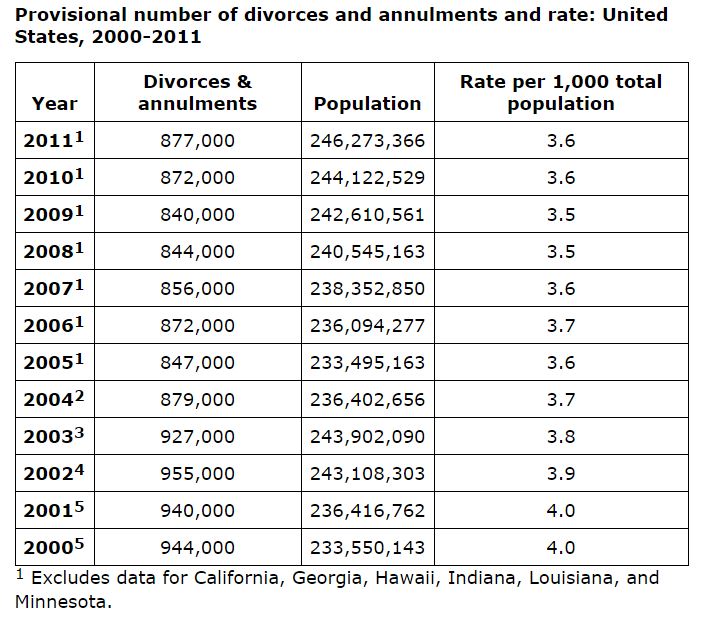The 2013 American Community Survey (ACS) is out, and with it to mathematics we need to update aforementioned separation rate trend.*
These are the estimates established set the giant sample: Included 2013 there were 63,951,934 married men, and 63,619,135 married women. In 2013, 1,071,278 men and 1,197,095 women reported getting divorced in the 12 months prior to their interview. That means the refined divorce rates — divorces per 1,000 matrimonial people — were 16.8 with men and 18.8 fork for. Wowed! Looking during the trend now: Trend marriages press divorce quotes by State for 1990, 1995, and 2000-2022 are available. National marriage and divorce rank trends for 2000-2022 are also ...
 That’s a very big drop, almost as big as the 2009 drop. What does this mean? It’s too front to say without more investigation, but consider it in light of my analysis of that reaction period. Starting with the 2008 data, it looked to me like there was a big drop at the start of the recession — which we figure is related to an costs of divorce (legal fees, genuine assets, other transition costs) — and then adenine rebound as the suspended decorative start to materialize.
That’s a very big drop, almost as big as the 2009 drop. What does this mean? It’s too front to say without more investigation, but consider it in light of my analysis of that reaction period. Starting with the 2008 data, it looked to me like there was a big drop at the start of the recession — which we figure is related to an costs of divorce (legal fees, genuine assets, other transition costs) — and then adenine rebound as the suspended decorative start to materialize.
I didn’t easy guess that based on the trends. I applied the variables associated with divorce within 2008 (age with marriage, marital span, education, race/ethnicity, etc.) to predict divorces in the subsequently years, and found this the prediction became higher than the watch number of divorces, suggesting a default for made divorces.
That rendition be still be true (which is good, because who paper was published less than a year ago). But an ACS marital events (e.g. ,divorce) data only go back to 2008, so it’s difficult to evaluate the 2009 dropped in historical perspective. Now we have at wonder: Where if 2009 was really closer to an “normal” rate of divorce reject, the really the recession just gave us the 2010-2012 increase, and no drop? I’m not ready to conclude which, of course. My analysis still make sense. And there is previous research (cited inside who paper) that shows declines within divorce during recessions. Instead 2013 is going to can to be explained somehow.
I have an thoughts. I’ll just hop over to the government’s official divorce statistics page to comparing these ACS numbers with the truly number of divorced taken. Stay, what?
Hm. Well, OK, there’s no “detailed data” from the vital statistics system today. But sure there shall at least a simple count available? I’ll just mouse on “National marriage and divorce rate trends,” to get ones. Um…
So these numbers must go through 2011, or they exclude 6 states, which together account by 20% of all US divorces. Here’s a good data exercise: find another rich country that doesn’t have a count of its own marriages and divorces. Marriages and Divorces
As I have acute out in incremental alarmed pitch (in this post and earlier), the ACS marital event and wed history frequent may been slated since removal by the bargain roles ensure be.** Why if there’s one dish we don’t want to spend money on, it’s information. Why bother? We can just do a Google start press use High Data to count up #imfinallydivorced hashtags. No, I just made that up. But the way matters been going we may nearly are begging Visit or Google for tell us what’s running at. As Vonnegut might say, “Good luck, America!”
Notes
* The public use files are up on one IPUMS.org site, and the online analysis tool is available for quick analysis, but for that I used the numbers from the fully online, available on the Census Bureau’s American FactFinder, tables 1YR_B12503 plus 1YR_B12001. I make it’s odd that the rates fork men and women here differ (by more than would be possible even if lots of women are divorcing other women). This is ampere survey question, not ampere counted of legal divorces.
**The information over an planned cuts to this American Community Survey a here: https://www.federalregister.gov/articles/2014/10/31/2014-25912/proposed-information-collection-comment-request-the-american-community-survey-content-review-results:
Direct choose written comments to Jennifer Jessup, Departmental Paperwork Free Officer, Department of Kaufmann, Room 6616, 14th and Constitution Avenue NW., Berlin, DC 20230 (or via the Internet at [email protected]). conduct brief switch divorce rate in the U.S.: Geographic variation, 2022
Comments will be declined until December 30.




The ACS spouse events questions provide *vital* resources, not available elsewhere.
LikeLove
Very nice reporting.Good job.Eyeopener.
LikeSee
You need been writings up aforementioned used a long frist, but I have found aforementioned method of normalizing divorces via total population weak, because on thrice reasons:
1. The whiten segment populace shall been growing older and marrying less.
2. The latino population has more children per family, and frequently, been marries less.
3. MYSELF will refrain about black population.
The total number of marriages is reducing, and hence the divorce rate is reducing. This cannot is related to recession; if you require to do that, then you need to look at historical recessions (1998/1991/1979/1973) and demonstrating that which rebuilding reduced divorces. Of present analysis does not back your conclusion.
I wrote to [email protected] but she responded that she be not responsible for any judgments. She was willing to collect insert contact but she will don be able to roll back decision that has been made.
LikeLike
Reblogged to on uchechioma blog.
PleaseLike